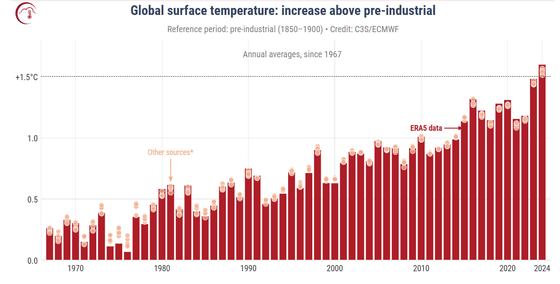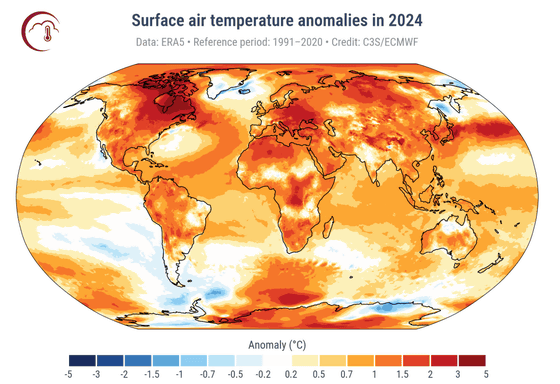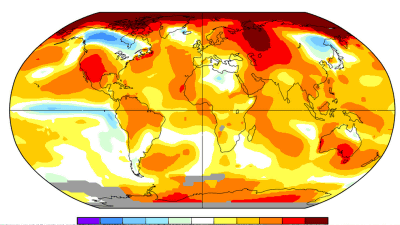2024 will be the hottest year on record for most continents, reaching 1.5 degrees Celsius or higher, EU report finds

In January 2025, the EU's
Global Climate Highlights 2024 | Copernicus
https://climate.copernicus.eu/global-climate-highlights-2024

Global temperatures passed critical 1.5°C milestone for the first time in 2024 – new report
https://theconversation.com/global-temperatures-passed-critical-1-5-c-milestone-for-the-first-time-in-2024-new-report-246821
Below is a graph showing the change in the difference between the 'global annual average temperature' and the 'temperature during the Second Industrial Revolution from 1850 to 1900.' Looking at the graph, we can see that the increase exceeded 1 degree for the first time in 2010, and has continued to exceed 1 degree every year since 2014, reaching +1.5 degrees in 2024.

Below is a graph showing by region how much the annual average surface temperature in 2024 will exceed the average from 1991 to 2020. The darker the red, the higher the increase. According to the graph, the eastern part of North America, Europe, and the Pacific Ocean area near Japan are particularly affected by the severe increase.

The standard of '1.5 degrees above pre-industrial levels' is based on the Paris Agreement adopted in 2015. The Paris Agreement stipulates that the increase in global average temperature from pre-industrial levels be kept below +2 degrees, and that efforts be made to prevent global warming with the aim of keeping it below +1.5 degrees. The basis for 1.5 and 2 degrees is that a 1.5 degree rise will result in the loss of 70-90% of coral reefs, and a 2 degree rise will result in the loss of 99%; a 1.5 degree rise will cause sea levels to rise by 0.1 meters, increasing the likelihood that up to 10 million people will suffer flood damage.
However, the Paris Agreement stipulates a 'long-term average' calculated over a 20-year period. Because weather fluctuates from year to year, exceeding the Paris Agreement standard by merely exceeding 1.5 degrees on average in one year does not mean that the long-term average is about +1.3 degrees, even including 2024. In 2024, a strong El Niño phenomenon is believed to have caused sea temperatures to rise, affecting weather patterns around the world, but this does not necessarily mean that global warming has progressed seriously.
On the other hand, according to Matthew Wright, a researcher specializing in atmospheric physics at the University of Oxford, the standards set by governments such as the Paris Agreement are merely standards, and from a scientific point of view, it is important not to stick too closely to arbitrary targets. In fact, there is research that shows that even a temperature rise of about 0.1 degrees will have a strong impact on sea level rise by melting the Greenland ice sheet, and in 2024, heat waves caused by extreme heat caused wildfires in Europe, and rising humidity caused devastating floods in many areas of Spain, leading to large-scale disasters.
The World Meteorological Organization (WMO) predicts that the La Niña phenomenon will occur from December 2024 to February 2025, but that its effects will be relatively weak and short-lived. Therefore, it is possible that 2025 will not be as hot as 2024, but Wright said that we should take note of the fact that the Paris Agreement threshold has been exceeded for the first time and pay renewed attention to climate change.
Related Posts:
in Science, Posted by log1e_dh







